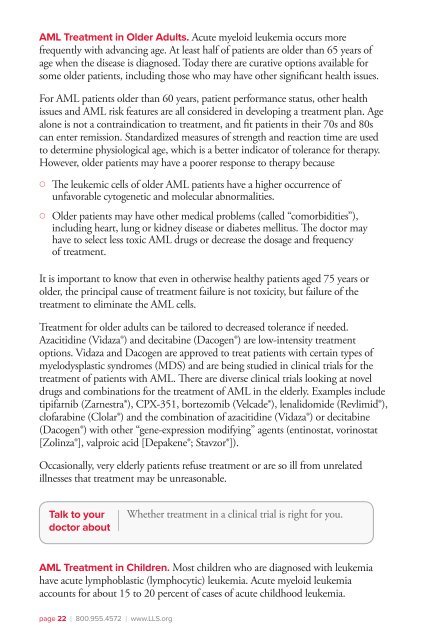Acute Myeloid Leukemia - The Leukemia & Lymphoma Society
Acute Myeloid Leukemia - The Leukemia & Lymphoma Society
Acute Myeloid Leukemia - The Leukemia & Lymphoma Society
- No tags were found...
You also want an ePaper? Increase the reach of your titles
YUMPU automatically turns print PDFs into web optimized ePapers that Google loves.
AML Treatment in Older Adults. <strong>Acute</strong> myeloid leukemia occurs morefrequently with advancing age. At least half of patients are older than 65 years ofage when the disease is diagnosed. Today there are curative options available forsome older patients, including those who may have other significant health issues.For AML patients older than 60 years, patient performance status, other healthissues and AML risk features are all considered in developing a treatment plan. Agealone is not a contraindication to treatment, and fit patients in their 70s and 80scan enter remission. Standardized measures of strength and reaction time are usedto determine physiological age, which is a better indicator of tolerance for therapy.However, older patients may have a poorer response to therapy because◦{<strong>The</strong> leukemic cells of older AML patients have a higher occurrence ofunfavorable cytogenetic and molecular abnormalities.◦{Older patients may have other medical problems (called “comorbidities”),including heart, lung or kidney disease or diabetes mellitus. <strong>The</strong> doctor mayhave to select less toxic AML drugs or decrease the dosage and frequencyof treatment.It is important to know that even in otherwise healthy patients aged 75 years orolder, the principal cause of treatment failure is not toxicity, but failure of thetreatment to eliminate the AML cells.Treatment for older adults can be tailored to decreased tolerance if needed.Azacitidine (Vidaza®) and decitabine (Dacogen®) are low-intensity treatmentoptions. Vidaza and Dacogen are approved to treat patients with certain types ofmyelodysplastic syndromes (MDS) and are being studied in clinical trials for thetreatment of patients with AML. <strong>The</strong>re are diverse clinical trials looking at noveldrugs and combinations for the treatment of AML in the elderly. Examples includetipifarnib (Zarnestra®), CPX-351, bortezomib (Velcade®), lenalidomide (Revlimid®),clofarabine (Clolar®) and the combination of azacitidine (Vidaza®) or decitabine(Dacogen®) with other “gene-expression modifying” agents (entinostat, vorinostat[Zolinza®], valproic acid [Depakene®; Stavzor®]).Occasionally, very elderly patients refuse treatment or are so ill from unrelatedillnesses that treatment may be unreasonable.Talk to yourdoctor aboutWhether treatment in a clinical trial is right for you.AML Treatment in Children. Most children who are diagnosed with leukemiahave acute lymphoblastic (lymphocytic) leukemia. <strong>Acute</strong> myeloid leukemiaaccounts for about 15 to 20 percent of cases of acute childhood leukemia.page 22 I 800.955.4572 I www.LLS.org
















